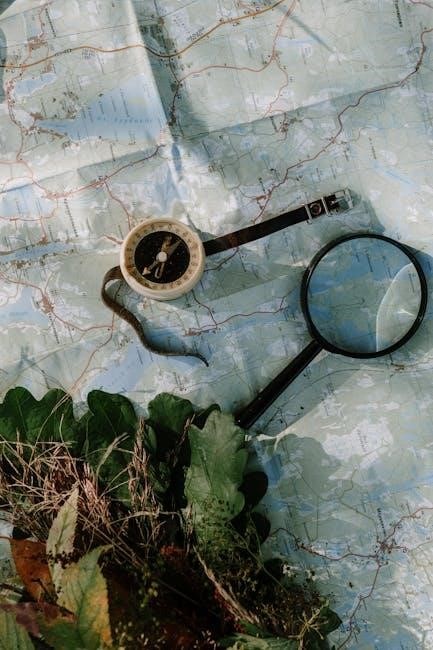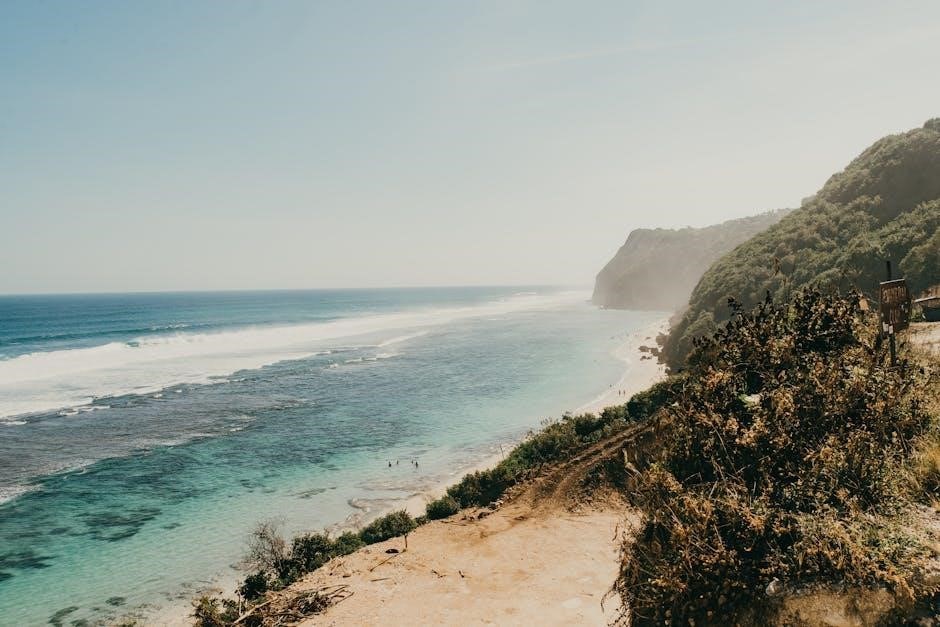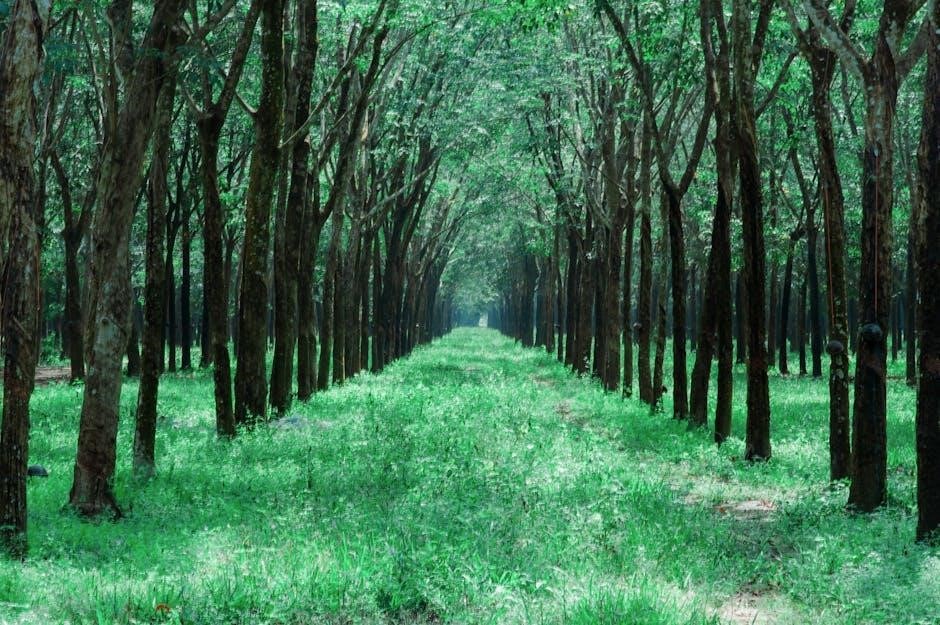Nature guiding is an immersive outdoor experience that connects people with the natural world, fostering appreciation and respect for ecosystems through educational and engaging exploration.
What is Nature Guiding?
Nature guiding is an outdoor activity where knowledgeable guides lead participants through natural environments, providing insights into local ecosystems, wildlife, and cultural heritage. It is a hands-on, interactive way to explore nature, fostering a deeper understanding of the environment. Guides share expertise on flora, fauna, and ecological processes, helping participants appreciate the interconnectedness of natural systems. Nature guiding often takes place in parks, forests, wetlands, and other wild areas, offering a unique opportunity to learn about and connect with the natural world. This approachable and engaging method of exploration is designed to be accessible to people of all ages and backgrounds, bridging the gap between humans and nature while promoting responsible environmental practices.

Importance of Nature Guiding
Nature guiding plays a vital role in fostering environmental awareness and promoting the conservation of natural resources. By educating participants about local ecosystems, guides inspire a sense of stewardship and responsibility toward the planet. Nature guiding also enhances outdoor recreation by providing safe and enriching experiences, helping people connect with nature in meaningful ways. It supports biodiversity by encouraging sustainable practices and raising awareness about the importance of protecting wildlife habitats. Additionally, nature guiding contributes to mental and physical well-being by offering a refreshing escape from urban life, reducing stress, and improving overall health. Through these efforts, nature guiding not only preserves the environment but also enriches the lives of individuals and communities, fostering a deeper appreciation for the natural world.
Benefits of Nature Guiding
Nature guiding offers numerous benefits, enhancing both physical and mental well-being while fostering a deeper connection with the environment. It promotes physical health by encouraging outdoor activity, reducing stress, and improving overall fitness. Mentally, it provides a refreshing escape from urban life, boosting mood and reducing anxiety. Nature guiding also enhances learning by offering insights into local ecosystems, wildlife, and conservation efforts, making it an educational and engaging experience. Additionally, it fosters social connections through group tours, creating opportunities to meet like-minded individuals. The exposure to diverse landscapes and species sparks curiosity and appreciation for biodiversity. Overall, nature guiding enriches lives by combining adventure, education, and relaxation, while promoting environmental awareness and personal growth.

Essential Skills for Nature Guides
Nature guides must possess strong navigation, survival, and communication skills, along with deep knowledge of local flora and fauna, to ensure safe and educational experiences in the wilderness.
Knowledge of Local Flora and Fauna
A nature guide must have extensive knowledge of the local flora and fauna, including plant species, animal behaviors, and their roles in the ecosystem. This expertise allows guides to identify edible plants, recognize poisonous species, and explain the importance of pollinators like bees. Understanding the habitats and migration patterns of wildlife ensures safer and more informative tours. Guides can share insights into how flora and fauna adapt to environmental changes, fostering a deeper appreciation for biodiversity. Practical knowledge of tracking and birdwatching techniques further enhances the experience, enabling visitors to connect with nature on a personal level. This foundational understanding is crucial for creating engaging and educational outdoor adventures.
Navigation and Survival Skills
Navigation and survival skills are essential for nature guides, ensuring they can lead groups safely in remote areas. Proficiency in using compasses, GPS devices, and maps is critical to prevent disorientation. Guides should also be adept at reading natural signs, such as the sun’s position, star constellations, and landscape features, to navigate without reliance on technology. Survival skills, including starting fires, finding water sources, and building shelters, are vital for handling emergencies. Knowledge of edible plants and first aid further enhances preparedness. These skills not only ensure the safety of participants but also allow guides to confidently lead expeditions into the wilderness. By mastering navigation and survival, guides can provide a secure and enriching experience for everyone involved in nature excursions.
Wildlife Tracking and Birdwatching

Wildlife tracking and birdwatching are core competencies for nature guides, enabling them to identify and interpret animal behavior, habitats, and patterns. Tracking involves observing footprints, scat, and other signs to locate species, while birdwatching focuses on recognizing plumage, songs, and flight patterns. These skills enhance the guide’s ability to provide enriching experiences by sharing insights into wildlife ecology. Knowledge of seasonal changes and habitat preferences allows guides to predict animal movements, increasing the likelihood of sightings. Additionally, these practices foster a deeper connection to nature, promoting conservation awareness and sustainable tourism. By mastering tracking and birdwatching, guides can offer meaningful, educational encounters that inspire appreciation for wildlife and their environments.
Effective Communication Techniques
Effective communication is crucial for nature guides to convey knowledge and inspire appreciation for the natural world. Clear and concise language ensures that information is easily understood by diverse audiences. Engaging storytelling and relatable examples help captivate interest and make complex concepts accessible. Active listening and adaptability are key, as guides must tailor their communication to the group’s needs and questions. Non-verbal cues, such as gestures and eye contact, enhance connection and enthusiasm. Additionally, patience and a friendly demeanor create a welcoming environment, encouraging participants to ask questions and learn. By mastering these techniques, nature guides can foster a deeper understanding and appreciation of nature, making their tours both informative and memorable.

Tools and Equipment for Nature Guides
Binoculars, compass, field guides, maps, first aid kits, and sturdy footwear are essential tools for nature guides to navigate, identify species, and ensure safety during outdoor adventures.
Binoculars and Optics
Binoculars are indispensable tools for nature guides, providing close-up views of wildlife and landscapes. High-quality optics with 7x or 8x magnification are ideal for clear, stable images. Waterproof and fog-proof designs ensure reliability in various conditions. Spotting scopes extend observation capabilities for distant subjects. UV protection and anti-reflective coatings enhance visibility. Familiarity with optics’ features, such as field of view and close focus, improves observational accuracy. Guides often recommend testing binoculars for comfort and ease of use, ensuring they suit individual preferences. Proper maintenance, like cleaning lenses and storing securely, prolongs their lifespan. Advanced optics, such as night vision or thermal imaging, offer specialized insights. Investing in durable, precise optics enhances the guiding experience, allowing for deeper connections with nature and more engaging encounters for participants.

Field Guides and Maps
Field guides and maps are essential tools for nature guides, providing critical information for identifying species and navigating landscapes. Detailed field guides cover local flora, fauna, and geological features, while maps offer spatial awareness and trail routes. Topographic maps highlight elevation changes, water sources, and habitats, aiding in route planning. Many guides also use digital tools like GPS devices or apps for real-time navigation. Marking important locations, such as wildlife hotspots or safety landmarks, enhances utility. Combining physical maps with field guides ensures comprehensive exploration. These resources empower guides to lead informed, engaging, and safe excursions, fostering deeper connections with nature for participants. Effective use of field guides and maps transforms outdoor experiences into educational and memorable journeys.
First Aid and Emergency Kits
First aid and emergency kits are vital for nature guides to ensure safety and preparedness in remote or challenging environments. A well-stocked first aid kit should include bandages, antiseptics, pain relievers, and supplies for treating minor injuries. Emergency kits should contain essentials like flashlights, whistles, emergency blankets, and multi-tools. Guides must also carry navigation aids such as compasses or GPS devices. Proper training in first aid and emergency response is crucial for handling unexpected situations effectively. These kits empower guides to address medical issues promptly and keep participants safe until professional help arrives if needed. Regularly updating and customizing kits based on the terrain and group needs ensures readiness for any scenario, making them indispensable tools for every nature guide.

Safety Tips for Nature Guides
Assess risks, plan routes, and stay informed about weather conditions. Carry emergency kits, use proper gear, and maintain clear communication to ensure a safe outdoor experience.
Preparing for Outdoor Adventures
Thorough preparation is essential for a safe and enjoyable outdoor experience. Start by researching the terrain, weather, and potential hazards of the area you plan to visit. Pack essential items such as sturdy footwear, layers of breathable clothing, and a reliable map or GPS device. Always bring sufficient water, non-perishable snacks, and a first aid kit. Inform someone about your itinerary, including where you’re going and when you expect to return. Check the weather forecast beforehand and be prepared for unexpected changes. Familiarize yourself with local regulations and permits required for the activity. Ensure your phone is fully charged and consider carrying a portable charger. Lastly, evaluate your physical condition and choose trails that match your fitness level to avoid exhaustion or injury.
Handling Wildlife Encounters
Encountering wildlife during outdoor adventures can be thrilling but requires caution. Always maintain a safe distance from animals to avoid startling them, as this can lead to defensive behavior. Keep calm and composed during an encounter, avoiding sudden movements or loud noises that might provoke them. Never feed or approach wildlife, as this can disrupt their natural behavior and create safety risks. If you encounter a predator, such as a bear or wild cat, stand tall, make yourself appear larger, and slowly back away without turning your back. Avoid running, as this can trigger a chase response. If necessary, use noise-making devices or bear spray to deter the animal. Stay in groups when exploring, as wildlife is less likely to approach people in larger numbers. Always be prepared and know how to react to specific species to ensure a safe and respectful interaction with nature.
Emergency Preparedness
Emergency preparedness is crucial for nature guides to ensure the safety of themselves and their groups. Always carry a first aid kit, a reliable means of communication, and a map of the area. Inform someone about your itinerary, including where you are going and when you plan to return. Pack essentials like water, non-perishable snacks, and a whistle to signal for help if needed. Familiarize yourself with the local emergency services and know how to contact them. Stay aware of weather conditions and potential hazards like flash floods or wildlife threats. Teach group members basic first aid and how to stay calm during emergencies. Regularly check and update your emergency supplies to ensure they are functional and relevant. By being proactive and prepared, you can minimize risks and respond effectively in critical situations, ensuring a safer outdoor experience for everyone involved.

Conservation and Sustainability
Nature guides play a vital role in promoting conservation and sustainability by educating visitors about eco-friendly practices and supporting efforts to protect biodiversity and natural habitats.
Role of Guides in Conservation
Nature guides play a crucial role in conservation by educating visitors about local ecosystems, promoting eco-friendly practices, and inspiring stewardship of the environment. They often collaborate with conservation organizations to monitor wildlife and habitats, reporting threats like pollution or illegal activities. By sharing knowledge about endangered species and the importance of biodiversity, guides raise awareness and encourage visitors to support conservation efforts. Many guides also participate in citizen science projects, contributing valuable data to environmental studies. Their advocacy for sustainable tourism practices helps protect natural areas while supporting local communities. Ultimately, nature guides act as ambassadors for the environment, fostering a deeper connection between people and nature, and motivating individuals to take action in preserving the planet for future generations.
Eco-Friendly Practices
Eco-friendly practices are essential for nature guides to minimize their impact on the environment while leading tours. Guides emphasize leaving no trace, ensuring that natural habitats remain undisturbed. This includes proper waste disposal, avoiding litter, and not removing plants or rocks from their natural settings. Many guides promote sustainable tourism by encouraging visitors to reduce their carbon footprint, such as using public transport or carpooling to tour locations. Additionally, guides often advocate for responsible wildlife viewing, maintaining safe distances to avoid stressing animals. By modeling and teaching these practices, nature guides inspire visitors to adopt environmentally conscious behaviors. These efforts not only protect ecosystems but also preserve the beauty of natural areas for future generations to enjoy.

Popular Nature Destinations
Popular nature destinations include iconic national parks, lush forests, and pristine wetlands, offering breathtaking landscapes and diverse wildlife for exploration and unforgettable outdoor experiences.
National Parks
National parks are protected areas that showcase stunning natural beauty, diverse ecosystems, and rich cultural heritage. These parks provide habitats for countless species, preserving biodiversity and offering breathtaking landscapes for exploration. From the geothermal wonders of Yellowstone to the rugged trails of the Great Smoky Mountains, national parks attract millions of visitors annually. They serve as vital educational resources, promoting environmental awareness and conservation efforts. Many parks also offer recreational activities such as hiking, camping, and wildlife watching, making them ideal destinations for nature enthusiasts. By visiting these areas, guides and tourists alike contribute to their preservation while experiencing the raw beauty of nature firsthand.
- Yellowstone National Park
- Grand Canyon National Park
- Great Smoky Mountains National Park
Forests and Wetlands
Forests and wetlands are among the most biodiverse ecosystems on Earth, providing vital habitats for countless species. Forests, ranging from dense tropical rainforests to expansive boreal woodlands, play a critical role in carbon sequestration and oxygen production. Wetlands, including marshes, swamps, and bogs, act as natural water filters and flood control systems while supporting unique aquatic life. Both environments offer opportunities for hiking, birdwatching, and canoeing, allowing nature guides to educate visitors about their ecological significance. These areas are also essential for scientific research, helping to preserve endangered species and maintain ecological balance. Exploring forests and wetlands under the guidance of knowledgeable experts ensures a deeper understanding and appreciation of these natural wonders.
- Tropical Rainforests
- Boreal Forests
- Marshes and Swamps
Nature guiding connects people to the outdoors, fostering appreciation and conservation while promoting sustainable tourism. It enriches lives and encourages environmental stewardship and responsible exploration.
Nature guiding offers a unique way to explore and understand the natural world, combining education, conservation, and personal growth. By sharing knowledge of local ecosystems, guides inspire appreciation and stewardship. Essential skills like wildlife tracking, navigation, and effective communication enhance the experience. Tools such as binoculars and field guides aid in exploration, while safety practices ensure memorable adventures. Conservation efforts are strengthened through sustainable practices and raising awareness. Popular destinations like national parks and wetlands provide diverse environments for discovery. Ultimately, nature guiding fosters a deeper connection between people and the environment, promoting lifelong learning and environmental responsibility.

Encouragement for Further Exploration
Nature guiding invites individuals to embark on a journey of discovery, fostering a deeper connection with the environment. Whether exploring vast national parks, serene wetlands, or vibrant forests, each destination offers unique opportunities to learn and grow. By engaging with knowledgeable guides, participants gain insights into local ecosystems, wildlife behaviors, and conservation efforts. This experience not only enriches personal knowledge but also inspires a sense of responsibility for protecting these natural wonders. For those eager to explore further, joining local nature groups, attending workshops, or volunteering for conservation projects can deepen their involvement. The rewards of nature guiding are limitless, encouraging lifelong curiosity and a commitment to preserving the world’s diverse landscapes for future generations.
